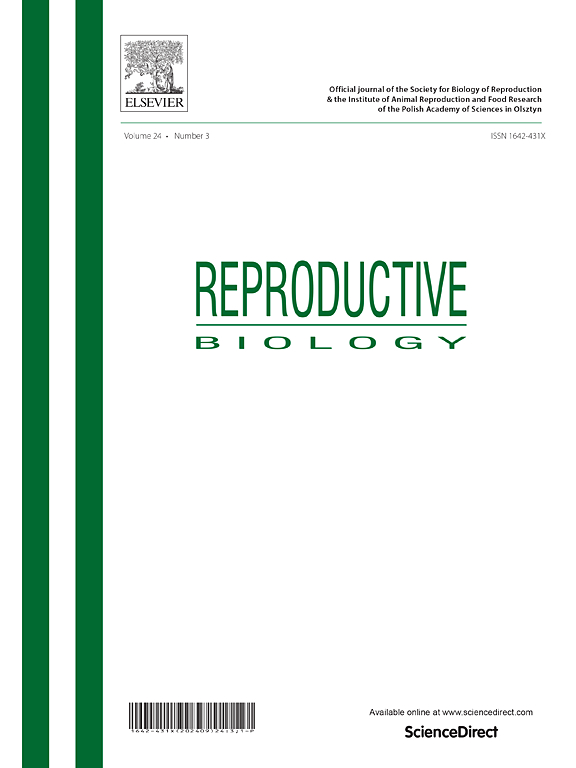Chemical profiling of testicular parenchyma in rams using an exploration of echointensity bands and the novel r-Algo computer algorithm increasing precision and accuracy of ultrasound image analyses
IF 2.5
3区 生物学
Q3 REPRODUCTIVE BIOLOGY
引用次数: 0
Abstract
The aim of this study was to utilize bitmap segmentation of ultrasound images to enhance the consistency and accuracy of determining the chemical composition of ram testicular parenchyma based on its first-order echotextural characteristics, including mean numerical pixel intensity (MPI), standard deviation of numerical pixel values (mean pixel heterogeneity-MPH), and pixel frequency distribution (mean pixel concentration-MPC). Testes (n = 10) were obtained post-mortem from ten different, sexually mature Karakul rams and scanned using an 8-MHz linear-array transducer in both longitudinal (Long) and transverse (Trans) planes. The crude fat, protein, and moisture contents of testicular tissue samples were measured using validated laboratory techniques. Digital ultrasonograms of the testicular parenchyma were normalized and converted to bitmap files using commercially available ImageProPlus® analytical software. Two segmentation approaches were compared to assess their ability to detect quantitative correlations between echotextural characteristics and proximate chemical composition of testicular tissue: echointensity (EI) banding and algorithmic segmentation of the bitmaps. Using 50- or 25-pixel intensity bands, only two Long EI bands and five Trans EI bands showed significant correlations between MPI, MPH, or MPC and testicular tissue constituents. The accuracy of predicting testicular composition using algorithmically identified pixel intensity clusters ranged from 85.41 ± 3.67 % (MPI-fat) to 99.69 ± 0.12 % (MPC-moisture) for Long images, and from 78.31 ± 5.24 % (MPI-fat) to 99.76 ± 0.06 % (MPH-moisture) for Trans images. These results suggest that computerized detection of specific pixel intensity ranges offers an optimal method for determining the correlations between first-order echotextural characteristics and the chemical composition of ram testes.
利用超声强度带和新型r-Algo计算机算法对公羊睾丸实质进行化学分析,提高超声图像分析的精度和准确性
本研究的目的是利用超声图像的位图分割技术,提高公羊睾丸实质一阶回声特征(包括平均数值像元强度(MPI)、数值像元值标准差(平均像元异质性- mph)和像元频率分布(平均像元浓度- mpc)判断化学成分的一致性和准确性。从10只不同的性成熟卡拉库尔公羊的死后获得睾丸(n = 10),并使用8 mhz线性阵列传感器在纵向(Long)和横向(Trans)平面进行扫描。使用经过验证的实验室技术测量睾丸组织样品的粗脂肪、蛋白质和水分含量。使用市售的ImageProPlus®分析软件将睾丸实质的数字超声图归一化并转换为位图文件。比较了两种分割方法,以评估它们检测回声纹理特征与睾丸组织近似化学成分之间定量相关性的能力:回声强度(EI)带和位图的算法分割。在50或25像素强度波段中,只有2条Long EI波段和5条Trans EI波段显示MPI、MPH或MPC与睾丸组织成分之间存在显著相关性。预测的准确性睾丸组合使用集群算法确定像素强度范围从85.41 ±3.67 % (MPI-fat) 99.69±0.12 % (MPC-moisture)长图片,和从78.31 ±5.24 % (MPI-fat) 99.76±0.06 % (MPH-moisture)反式图像。这些结果表明,计算机检测特定像素强度范围为确定一阶回声特征与公羊睾丸化学成分之间的相关性提供了一种最佳方法。
本文章由计算机程序翻译,如有差异,请以英文原文为准。
求助全文
约1分钟内获得全文
求助全文
来源期刊

Reproductive biology
生物-生殖生物学
CiteScore
3.90
自引率
0.00%
发文量
95
审稿时长
29 days
期刊介绍:
An official journal of the Society for Biology of Reproduction and the Institute of Animal Reproduction and Food Research of Polish Academy of Sciences in Olsztyn, Poland.
Reproductive Biology is an international, peer-reviewed journal covering all aspects of reproduction in vertebrates. The journal invites original research papers, short communications, review articles and commentaries dealing with reproductive physiology, endocrinology, immunology, molecular and cellular biology, receptor studies, animal breeding as well as andrology, embryology, infertility, assisted reproduction and contraception. Papers from both basic and clinical research will be considered.
 求助内容:
求助内容: 应助结果提醒方式:
应助结果提醒方式:


